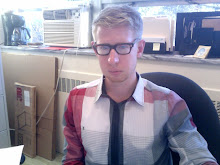
I made a small body of work this past summer after reading
Picturing Men: A Century of Male Relationships in Everyday American Photography by John Ibson. Ibson has collected old personal photographs of men together in the past century. These men are pictured in time-appropriate heterosexual formats, but their sexualities are blurred or unknown, and they are most certainly viewed in a queer context in present day. John Ibson argues in his book that we must blind ourselves to these men’s sexualities, as they are not explicitly known and most likely these men were best friends and experienced a certain intimacy unknown in today’s male friendships. I do not think we should be blind to these men’s sexualities—I think we should eyes and mind wide open. Afterall, why couldn’t they be queer? The same justifications for their probable heterosexuality can be used to justify their questionable homosexuality. The only given is that there are many layers to these men’s stories, which one assessment of a photograph cannot ultimately reveal.
Thinking about the subjective history of sexuality and the idea of reinvestigating historical material using a queer lens is what prompted me to make this work. I have focused on hidden layers of sexuality and the multiple barriers and facades that obscure them, or don't. Peepholes as part of an incomplete barrier revealing what is hidden behind the surface are used prominently in these pieces. I have pieced together torn pages from heterosexual romance novels to create a straight barrier through which we are only allowed a glimpse of the queer subject matter by select revealing peepholes. These quilt-like panels function as screens of altered concealment, creating one layer of distance from the pictured men and the heterosexual material, and another layer of distance between the queer subject matter and the viewer.
Images from
peepholes:



quotes from the book:
"The photographs are quite silent about the sexuality of their subjects…but the photographs do speak, often unmistakably, about a matter of perhaps greater importance than sex in human interaction: genuine intimacy. "
"Beginning before the Civil War, in daguerreotypes, ambrotypes, cartes de visite, and tintypes, certain sorts of body language recurred time and again in studio portraits of men together. Entwining arms was common, as was holding hands in some fashion or another…. The utterly placid facial expressions of many of the men in these photographs suggest their comfort and familiarity with one another’s intimate touch. "
"A definite closeness was conveyed in many of the early-twentieth-century portraits of male couples. One is curious about what two men meant when they posed by a sign reading “Two of a Kind,” or what might have been meant by an inscription on the back of once cozy couple’s portrait that describes one man as the other’s “boyfriend.” Even nearly a century later, an occasional coupling…seems to convey not just romance but perhaps a sexual relationship. Others, like so many from even earlier times, are not necessarily romantic or sexual but do unambiguously demonstrate the comfort that American men still felt with intimate body language."







